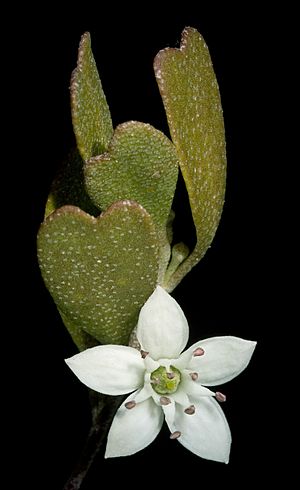Rhadinothamnus rudis facts for kids
Quick facts for kids Rhadinothamnus rudis |
|
|---|---|
 |
|
| Scientific classification |
Rhadinothamnus rudis is a cool little shrub that grows in Western Australia. It has thin, angular branches that look a bit like needles. When it blooms, you'll see pretty white flowers at the ends of its branches. This plant, along with its different types (called subspecies), is special because it only grows in Western Australia – you won't find it naturally anywhere else in the world!
Contents
What Does Rhadinothamnus rudis Look Like?
Rhadinothamnus rudis is a shrub that can grow up to 1.5 m (4 ft 11 in) (about 5 feet) tall. Its branches are often angular, meaning they have slight edges instead of being perfectly round.
Leaves and Flowers
The leaves of this plant can look different from one plant to another. They might be wide or narrow, or even almost round. They are usually 7–35 mm (0.28–1.38 in) long, with smooth edges. The leaves feel papery to leathery and are smooth. They grow on a short stalk called a petiole.
The white flowers grow one by one where the leaves meet the stem. Each flower sits on a small, angular stalk called a pedicel, which is 3–10 mm (0.12–0.39 in) long. The flowers are about 2.5–3 mm (0.098–0.118 in) wide, and their undersides are covered with tiny, shiny scales. The parts of the flower that make pollen, called stamens, are a little shorter than the petals.
Fruit
After the flowers, the plant produces a fruit that is a small capsule, about 5 mm (0.20 in) high. It's mostly smooth and can have a short, pointy tip or a blunt, rounded end. You can see this plant flowering all year round, from January to December.
How Was Rhadinothamnus rudis Named?
This plant was first officially described in 1845 by a scientist named Friedrich Gottlieb Bartling. He gave it the name Phebalium rude. His description was published in a book called Plantae Preissianae by Johann Georg Christian Lehmann.
Later, in 1998, another scientist named Paul G. Wilson changed the plant's name to Rhadinothamnus rudis. He published this name change in a science journal called Nuytsia.
Subspecies of Rhadinothamnus rudis
Paul Wilson also described three different types, or subspecies, of Rhadinothamnus rudis. These are all recognized by the Australian Plant Census. They are:
- Rhadinothamnus rudis subsp. rudis: This type has young branches that are clearly angular. Its leaves are 7–35 mm (0.28–1.38 in) wide, and its seed capsule usually has a short, pointy end.
- Rhadinothamnus rudis subsp. amblycarpus: The young branches of this subspecies can be slightly or very angular. Its leaves are shaped like a linear-wedge or a narrow to wide heart, measuring 15–17 mm (0.59–0.67 in) long and 4–9 mm (0.16–0.35 in) wide. The seed capsule is rounded at the top with a blunt, rounded end.
- Rhadinothamnus rudis subsp. linearis: This type has thick, narrow leaves that get a bit thinner towards the bottom. They are about 20 mm (0.79 in) long and 1–1.5 mm (0.039–0.059 in) wide, with a rounded tip. Its seed capsule is more or less square, ending in a tiny, triangular point.
Where Does Rhadinothamnus rudis Live?
Rhadinothamnus rudis grows in Western Australia, from the city of Albany all the way to Esperance on the south coast. You can find it on hills and plains, growing in different types of soil like clay, sand, rocky soils, limestone, laterite, and quartzite.
Where Each Subspecies Grows
- Subspecies rudis is found near the south coast, between Point Irwin and Cape Arid. It often grows over limestone on plains and gravelly hillsides. It flowers all year.
- Subspecies amblycarpus grows on the south coast, a bit further inland from Nyabing to Esperance. It flowers on and off throughout the year.
- Subspecies linearis lives in the Russell Range. It prefers shallow, sandy soils over quartzite or granite rocks. This subspecies also flowers throughout the year.

